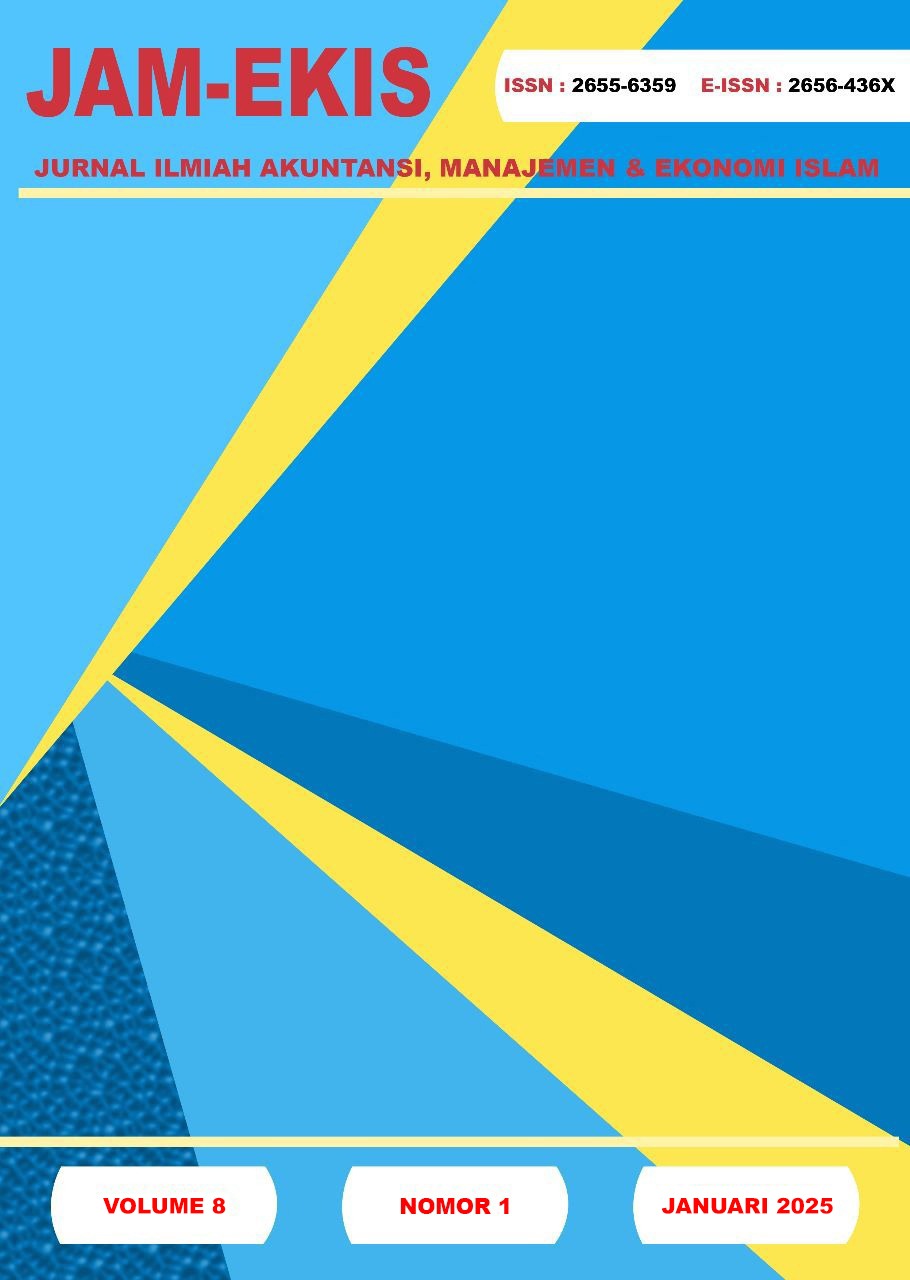ADOPSI QRIS OLEH PEDAGANG TERAS MALIOBORO 1: ANALISIS KUALITAS LAYANAN DAN KEMUDAHAN PENGGUNAAN
DOI:
https://doi.org/10.36085/jamekis.v8i1.7408Abstract
This study aims to study how service quality and ease of use impact the behavior of Teras Malioboro 1 merchants who switch from cash payments to QRIS. The increasing adoption of digital payment systems in Indonesia has made QRIS the main choice for street vendors to facilitate non-cash transactions. The quantitative method used in this study through a survey involving 275 merchants as respondents. The Structural Equation Modeling Partial Least Squares (SEM-PLS) method was used to analyze the data after being collected through a questionnaire. The results showed that the tendency of merchants to switch to QRIS was significantly influenced by ease of use, while service quality had an effect, but not directly. This indicates that the ease of using QRIS is more encouraging for merchants to switch from cash to digital payments than service quality. Thus, to increase QRIS adoption, primary attention should be paid to simplifying the interface and accessibility for merchants. This study contributes to the development of technology adoption strategies in the MSME sector and can assist policy makers in encouraging financial inclusion through the use of digital payment systems
References
Afandi, M. A. (2020). Switching Intentions Among Millennial Banking Customers to Fintech Lending. International Journal of Islamic Economics and Finance (IJIEF), 3(2), 283–304. https://doi.org/10.18196/ijief.3230
Andinia, S. N., Prakarsa, G., & Nasution, V. M. (2023). Analisis Faktor-faktor yang Mempengaruhi Penerimaan Pengguna QRIS di Indonesia. 13(2), 201–212.
Cenamor, J., Parida, V., & Wincent, J. (2019). How entrepreneurial SMEs compete through digital platforms: The roles of digital platform capability, network capability and ambidexterity. Journal of Business Research, 100(April), 196–206. https://doi.org/10.1016/j.jbusres.2019.03.035
Damayanti, M., Scott, N., & Ruhanen, L. (2017). Coopetitive behaviours in an informal tourism economy. Annals of Tourism Research, 65, 25–35. https://doi.org/https://doi.org/10.1016/j.annals.2017.04.007
Desmaryani, S., Soleh, A., & Wiarta, I. (2024). Heliyon Integration of technology acceptance models and government support to improve digital literacy. Heliyon, 10(14), e34086. https://doi.org/10.1016/j.heliyon.2024.e34086
Edu, A. S. (2024). Paths to digital mobile payment platforms acceptance and usage: A topology for digital enthusiast consumers. Telematics and Informatics Reports, 15(July), 100158. https://doi.org/10.1016/j.teler.2024.100158
Finthariasari, M. F., Herwan, M. D. K., & Nita, Z. A. (2023). The Influence Of Promotional Strategies And Social Media On Purchase Decisions (Case Study on Buyers Using Ms Glow Skincare in Bengkulu City). Ekombis Review: Jurnal Ilmiah Ekonomi Dan Bisnis, 11(1), 857-866.
Finthariasari, M. F., Ratnawili, R., & Halim, N. (2022). Purchasing Decisions: The Analysis Effect Of The Variables Life Style, Celebrity Endorser, And Brand Image. EKOMBIS REVIEW: Jurnal Ilmiah Ekonomi Dan Bisnis, 10(2), 661-672.
Finthariasari, M., & Zetira, A. M. (2022). Purchase Intention: Pengaruh Price Discount, Bonus Pack Dan Celebrity Endorser. Jurnal Bisnis dan Manajemen (JBM), 16-25.
Fitri, Marliza Ade., Khairiyah, Diah.(2015). Persepsi Konsumen Terhadap Penjualan Melalui Media Internet (Studi Kasus Pada Mahasiswa Fakultas Ekonomi Universitas Muhammadiyah Bengkulu Angkatan Tahun 2015). Jurnal Ilmiah Akuntansi, Manajemen dan Ekonomi Islam (JAM-EKIS).
Gong, X., Liu, X., & Xiao, Z. (2022). A dedication-constraint model of consumer switching behavior in mobile payment applications. Information & Management, 59(4), 103640. https://doi.org/https://doi.org/10.1016/j.im.2022.103640
Gunawan, A., Fatikasari, A. F., & Putri, S. A. (2023). The Effect of Using Cashless (QRIS) on Daily Payment Transactions Using the Technology Acceptance Model. Procedia Computer Science, 227, 548–556. https://doi.org/10.1016/j.procs.2023.10.557
Hizam, A. S., Mohamed, N., & Nelfiyanti. (2024). Study of SME employees’ awareness level on lean manufacturing and ergonomics implementation in Malaysian and Indonesian production environments. Heliyon, 10(18), e38216. https://doi.org/10.1016/j.heliyon.2024.e38216
John, Z., Belmonte, A., Tri, Y., Madel, M., Cahigas, L., Nadlifatin, R., Janice, M., & Gumasing, J. (2024). Acta Psychologica Factors influencing the intention to use e -wallet among generation Z and millennials in the Philippines : An extended technology acceptance model (TAM) approach. Acta Psychologica, 250(October), 104526. https://doi.org/10.1016/j.actpsy.2024.104526
Kilay, A. L., Simamora, B. H., & Putra, D. P. (2022). The Influence of E-Payment and E-Commerce Services on Supply Chain Performance: Implications of Open Innovation and Solutions for the Digitalization of Micro, Small, and Medium Enterprises (MSMEs) in Indonesia. Journal of Open Innovation: Technology, Market, and Complexity, 8(3), 119. https://doi.org/10.3390/joitmc8030119
Kusuma, M., Arianto, T., & Finthariasari, M. (2021). Analisis Pengaruh Minat Dan Motivasi Terhadap Keputusan Memilih Program Studi Dimediasi Variabel Pekerjaan Yang Diharapkan. Jurnal Manajerial, 8(03), 278-293.
Lonardi, H., & Legowo, N. (2021). Analysis of Factors Affecting Use Behavior of QRIS Payment System in DKI Jakarta. Turkish Journal of Computer and Mathematics Education, Research Article, 12(6), 3709–3728.
Nguyen, C. Q., Nguyen, A. M. T., & Tran, P. (2024). Assessing the critical determinants of cross-border E-commerce adoption intention in Vietnamese small and medium-sized enterprises: PLS-SEM algorithm approach. Journal of Open Innovation: Technology, Market, and Complexity, 10(1), 100257. https://doi.org/10.1016/j.joitmc.2024.100257
Oktarini, D., Finthariasari, M., Nuari, T. N. V., Marta, F. R., & Yami, F. M. (2022, April). Strategi Desain Produk Dan Kualitas Produk Terhadap Minat Beli Konsumen Pada Toko Mebel Sederhana. In Prosiding Seminar Nasional Business Corporate (Vol. 1, No. 1, pp. 135-146).
Parasuraman, A. P., Berry, L., & Zeithaml, V. (1991). Refinement and reassessment of the SERVQUAL scale. Journal of Retailing, 67, 420–450.
Pingali, S. R., Singha, S., Arunachalam, S., & Pedada, K. (2023). Digital readiness of small and medium enterprises in emerging markets: The construct, propositions, measurement, and implications. Journal of Business Research, 164, 113973. https://doi.org/https://doi.org/10.1016/j.jbusres.2023.113973
Pratiwi, M. P., Sari, A. R., Praditya, S., Manajemen, S., & Bisnis, F. (2022). Relokasi Malioboro Terhadap Pedagang Kaki Lima Khazanah : Jurnal Mahasiswa Khazanah : Jurnal Mahasiswa. Jurnal Khazanah, 14(2), 56–63.
Rahayu, T. S. M., Budiningsih, S., & Purwidianti, W. (2024). Determining Factors of Behavioral Intention to use Digital Payment QRIS at Traditional Market in Purwokerto. Asian Journal of Economics, Business and Accounting, 24(3), 260–268. https://doi.org/10.9734/ajeba/2024/v24i31259
Sismanto, A., Ranidiah, F., & Tarisa, A. (2021). Pengaruh orientasi pasar dan inovasi produk terhadap kinerja bisnis (studi kasus pada toko roti panggang banjar di sawah lebar kota bengkulu). Jurnal Ilmiah Akuntansi, Manajemen dan Ekonomi Islam (JAM-EKIS), 4(2).
Yang, J., Wu, Y., & Huang, B. (2023). Digital finance and financial literacy: Evidence from Chinese households. Journal of Banking and Finance, 156(February 2021). https://doi.org/10.1016/j.jbankfin.2023.107005







